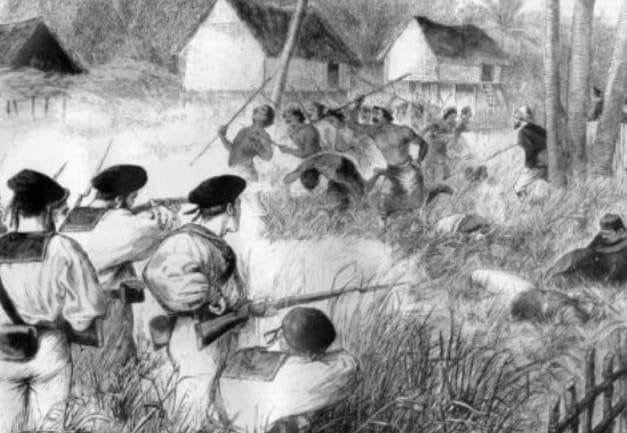
Perang Gerila di Kota Lama Kanan (Kuala Kangsar perak )
Colbourne assigned Ross to command the Larut Field Force and to disarm Kota Lama, the very anti-British village on the upper Perak River where Birch had been earlier driven away; the houses of known insurgents were to be destroyed. Ross worked with Commander Edmund St. J. Garforth, Royal Navy, of the Philomel to mount an operation from Kuala Kangsar against Kota Lama. The soldiers and seamen rafted up the Larut River and then marched overland to Kuala Kangsar on the Perak River. Garforth’s Naval Brigade consisted of 107 officers and men from Modeste.
Kota Lama was located 2.5 kilometres up the Perak River on the opposite bank to Kuala Kangsar. On 4th January 1876 Ross ordered advances on both banks and up the river. On the left bank, the Kota Lama side, Lieutenant Colonel Cox commanded 12 artillerymen and one 7-pounder gun, 10 men of the 3rd Regiment (The Buffs), and 25 men of the 1st Goorkhas; also with Cox was Mr. Maxwell, the British Deputy Commissioner for the region. On the right bank Captain G. Young (Goorkhas) commanded 50 men of The Buffs and 20 men of the 1st Goorkhas. Captain Speedy with some of his Sikhs supported Young. On the river Commander Garforth led three boats containing three naval officers and 29 seamen; Ross and his staff were also in the boats. Young had been ordered not to destroy property as the village he was advancing to, opposite Kota Lama, was deemed to be friendly.
Garforth’s boats landed just above Kota Lama. Leaving nine seamen as guards the remaining sailors went towards the village with Ross and his staff expecting to meet Cox and his group. Lieutenant John Hare, Royal Engineers, joined them with 4 Goorkhas who had been assisting Hare in measuring distances along the river bank. In fact Cox and his men had already searched the village and then followed tracks into the jungle.
As Ross’s group encountered houses they searched them for weapons and then moved on towards the centre of the village. After around 90 minutes spent searching empty houses some were found containing women and children. At that moment, about 1100 hours, around 50 Malays rushed out of the nearby jungle, a few carrying firearms and the rest holding spears. The Malays swept right into the British group, killing three men and wounding four others. Ross and his men were shocked, and as they were nearly surrounded they fought a withdrawal action.
Surgeon Townsend, Army Medical Department, was attacked by three Malays; he shot one with his pistol who fell over knocking Townsend down. The other two Malays moved in for the kill but Able Seamen Harry Bonnett and Henry Thompson rushed forward and killed the attackers.
The Brigade Major, Major Henry Lumsden Hawkins, Bengal Staff Corps, was killed by a spear. The Buffs’ Surgeon-Major William Collis reported: “spear wound two inches below the apex of heart; spear transfixing the chest and lungs, passing downwards and wounding diaphragm and liver, passing out below 10th and 11th rib at right angles”. Able Seaman David Sloper stood by Major Hawkins and killed two Malays before Hawkins ordered him to withdraw to safety.
Ross’ orderly, Goorkha Sepoy Baskur Rana, fought bravely, saving Ross’ life; other Gurkhas named for exceedingly good behaviour during the fight were Sepoys Kishanbir Thapa and Chanderbir Garti. Seaman Gunner William G. Loam of HMS Philomel and Goorkha Sepoy Jangbir Basnait were also killed by spears.
Besides Surgeon Townshend three others were wounded by spears: Private Jasper Ball, Royal Marines, who died 18 hours later, and Goorkha Sepoys Jhagru Thapa and Karak Sing Tapah. The wounds of all the casualties testified to the close-quarter of the fighting whilst the Goorkha casualty list testified to the aggressive combat spirit of the Nepalese.
The Malays swiftly returned to the jungle leaving five dead behind. Cox’s group appeared from the jungle without having fired a shot and burned Kota Lama down. Across the river Young had searched his village without opposition. Ross’s group spiked and threw into the river a big iron 12-pounder gun and returned to Kuala Kangsar with a large quantity of spears, muskets and small wall-pieces (cannon with mounts for walls). Ross and Garforth garrisoned Kuala Kangsar and then withdrew.
Source
Plagiarism is the copying & pasting of others work without giving credit to the original author or artist. Plagiarized posts are considered spam.
Spam is discouraged by the community, and may result in action from the cheetah bot.
More information and tips on sharing content.
If you believe this comment is in error, please contact us in #disputes on Discord
Hi! I am a robot. I just upvoted you! I found similar content that readers might be interested in:
http://kaiserscross.com/304501/471964.html